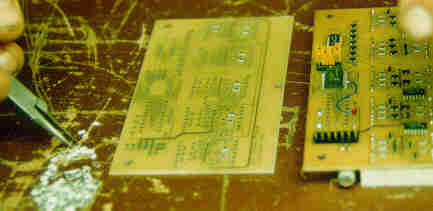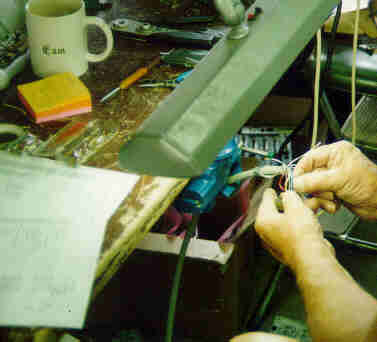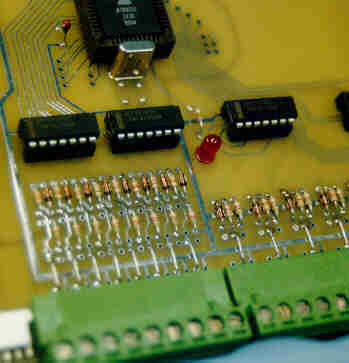EVENT HORIZONS
Military Air Traffic Control
Event Horizons was contracted to construct a number of components
as part of an upgrade to the Air Traffic Control System at a military installation.
The components ranged from the very simple to very complex. Since the
project was a prototype installation for the military, there were many
design and concept changes through the course of the project. Event
Horizons adapted quickly to these changes and worked closly with the
customer to provide them with what they actually wanted, rather then
what was originaly specified. Like any large project, a close
relationship with the customer was necessary to produce a product that
performed as needed.
Many of the system components required only a few pieces to be built,
including spares, but several required that small quantities be
assembled.
Each component was designed, built and then deployed to the field.
As design changes became necessary, the changes were first implemented
in the lab, then units were brought back from the field for updates.
Every lesson learned was also applied to other system elements.
The following is a list of the components constructed for this effort:
- Environmental Display Panel
- The Air-Traffic control personnel and pilots in the Air Terminal
receive weather information on these large displays. The display is
readable across the briefing room, over fourty feet away, and contains data on wind,
gusts, temperature and altimeter setting, as well as displaying the
current date, time, zulu time and the location from which the weather
conditions were read.
- Crash Telephone
- This is the simplest component. The military installation already had
a crash telephone system, where if any telephone was picked up, all
other phones would ring. The crash telephone was a standard telephone
instrument with a ringer, but with no dialing capability.
- Microphone Panel
- This panel accepts a standard Plantronics microphone/headset
and transmits and receives audio over the telco 4W E&M standard interface. It has
seperate volume controls for the panel speaker and for the headset, as
well as indicator lamps for receive and transmit audio.
- Radio Remote Control System
- One premise for the entire system was that the military installation
is located in a region with many hills and valleys, limiting line-of-sight
communications. Therefore, three sites were selected and set up
with a number of standard aircraft ARC-type radios. The ARC radios
chosen are fully remote controllable: Power, mode and frequency can
be set. For each radio there is a Radio-Remote-Control (RRC)
module that can be controlled via a multi-drop RS-232 control line.
Over thirty RRC modules were produced and installed, allowing each radio
to be individualy controlled. The audio and key-line for each radio is
provided via standard telco 4W E&M.
- Radio Crossbar
- One advantage of having radios that are individually tunable is that
if a radio fails, then another radio can be substituted immediately. To
facilitate the swapping of radios, the radio crossbar was designed and
built. This crossbar allows a maximum of 16 subscribers to connect to
one or more of 32 radios. A few clicks of a mouse and you can replace a
failed radio or add a radio to your microphone.
- Radio-Frequency Combiner-Amplifier System
- A disadvantage of having a large number of radio tranceivers located
at a site is the "Antenna Farm" problem. If you need to add another
radio, you have to install another antenna, which can be very expensive
and can cause long delays.
To bypass this, Event Horizons developed a system that seperates the
Receive and Transmit of the radio and routes the signal into common
antennas through a sequence of band-pass filters and amplifiers. The
net effect is only six antennas are required to cover three bands.
- Alarm Display Panel and Alarm Transmitters
- The radio sites are very remote, some are accessable only by helicopter.
As a result, each site has Emergency Power Generators and LPG fuel tanks.
One site even uses Photovoltaics for its primary power. To monitor each
site, there is an alarm "encoder" installed that transmits data from up
to sixteen discrete sensors to a central alarm display panel. If a sensor
is triggered, a light flashes on the display panel accompanied by an audio
alarm. The operator may silence the audible alarm. If communications is
lost, then the entire alarm panel is triggered.
- Ringdown Telephone System
- This is probably the most unique component of the system. The term
"Ringdown" usually means that if the handset is picked up, the opposite end
will ring. In this system, there are up to sixteen phones, and each may
call any other. There is never a "busy" signal, that is, if a phone is in
use, the caller is "added" to the circuit, creating a multi-way conversation.
The system supports a maximum of eight seperate conversations and up to
sixteen people may be in the same circuit.
- Automated Terminal Information System (ATIS) Recorder/Player
- The ATIS is intended to provide pilots with up-to-date information on
weather and airport conditions.
The ATIS panel is a digital recorder for up to two minutes of high quality
audio. After the operator records a message, the message is transmitted
repeatedly until replaced with a new message.
The environmental display panels each use 13 LED modules and each module displays
5 characters that are 7 dots high by 5 dots wide. These modules have to
be compact, requiring extensive use of surface-mount parts. The production
of just over 100 LED modules was not enough to go to a commercial assembly house, but
was enough to encourage use of time-saving production methods. Here a technician
places components by hand onto a PCB that has had solder paste screened
onto the pads. After all parts are placed, the PCB is placed into
an oven where a precise temperature profile re-flows the solder. After
reflow, the through-hole parts are then hand assembled.

A significant amount of resources on the AFFS project was expended on
connectivity issues. Here, a technican assembles a MIL-SPEC cable, to
connect to a military radio.

The project was intended as a prototype development effort, using best
commercial practices. This close-up photo shows part of the alarm transmitter
circuit board. Note the lack of solder mask and silk-screening. PCB's
were laid out and fabricated in as little as 48 hours as costs of less then
$1 per square inch. (An important feature in a project that produced 16
different PCB's, totaling over five thousand square inches of material!)

[Home]
[Contact Us]
This page was last updated 3 July 2003.



